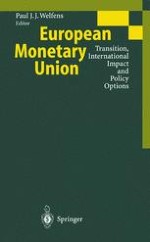1997 | OriginalPaper | Buchkapitel
EMU: A German Viewpoint
verfasst von : Heinrich Matthes
Erschienen in: European Monetary Union
Verlag: Springer Berlin Heidelberg
Enthalten in: Professional Book Archive
Aktivieren Sie unsere intelligente Suche, um passende Fachinhalte oder Patente zu finden.
Wählen Sie Textabschnitte aus um mit Künstlicher Intelligenz passenden Patente zu finden. powered by
Markieren Sie Textabschnitte, um KI-gestützt weitere passende Inhalte zu finden. powered by
1. Europe is marked by great tensions between its economic and currency areas (Predöhl, 1971). The European economic area, one of the cornerstones of what is fundamentally still a tricentric world economy, is divided into numerous nationally defined currency areas. In Europe this leads to sharp deviations from the optimum spatial situation such as exists, for example, in the United States whose economic area is not subdivided by many national borders with disintegrating effects. Thus there are still fourteen currencies in the European Union alone. In practical terms this means that substitutive core internal trade in Europe, which accounts for some two thirds of cross-frontier European “foreign trade”, cannot be organized according to purely economic, spatial laws. For Europe, compared with the United States (and also Japan), this entails the continuation of many barriers to trade and, accordingly, a less than optimum division of labor. The corresponding costs have been estimated by the Commission to be equivalent to 3 to 5% of European national product (Cecchini Report). What is at stake here, given the completion of the internal market, is: (a)a significant cost reduction because firms can produce for wider sales areas through economies of scale,(b)increased efficiency in firms, not least because of a rationalization of the industrial structure as a result of more competitive markets,c)a division of labor between firms that is closer to the optimum situation as a result of a better utilization of comparative cost advantages, and(d)greater market dynamism and stemming from this, more innovation.
